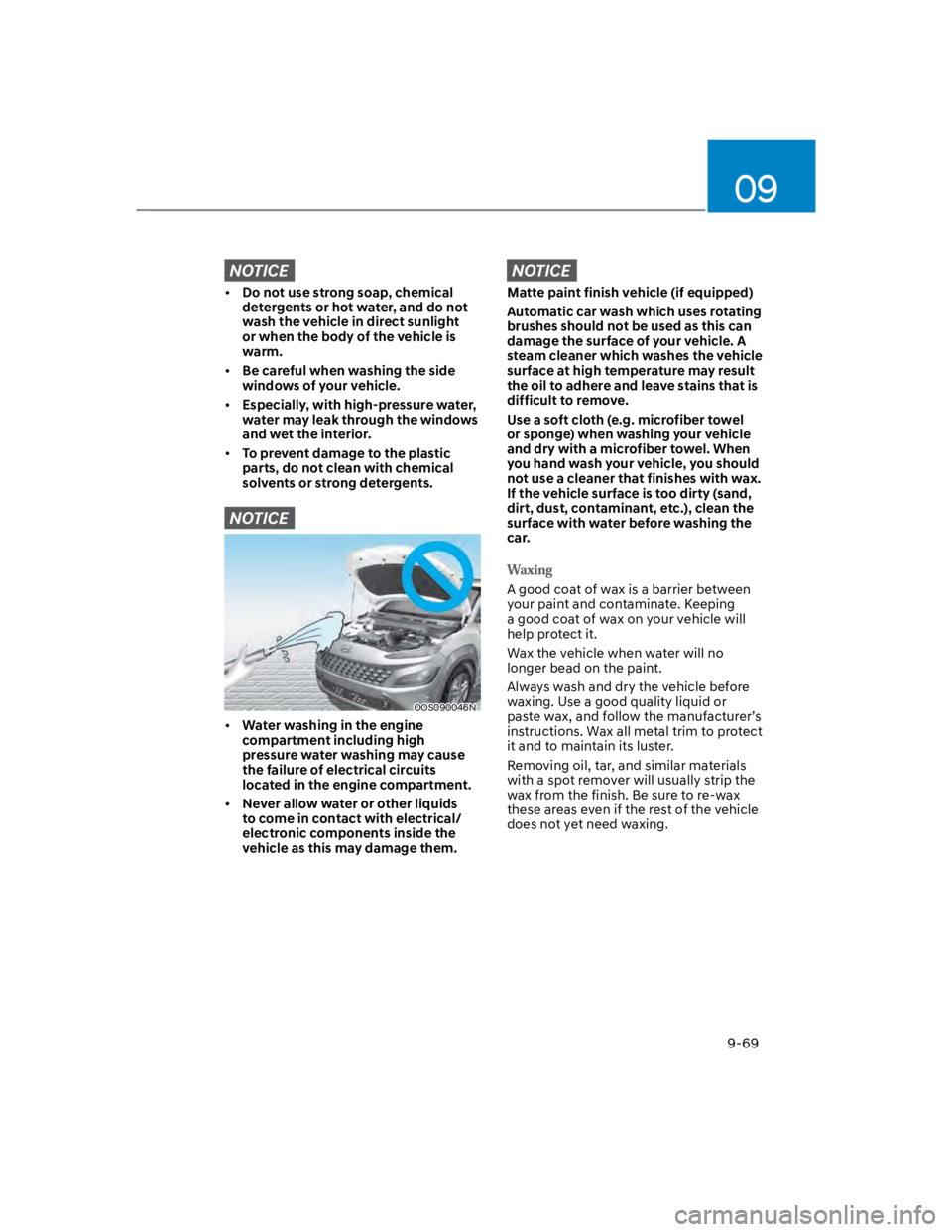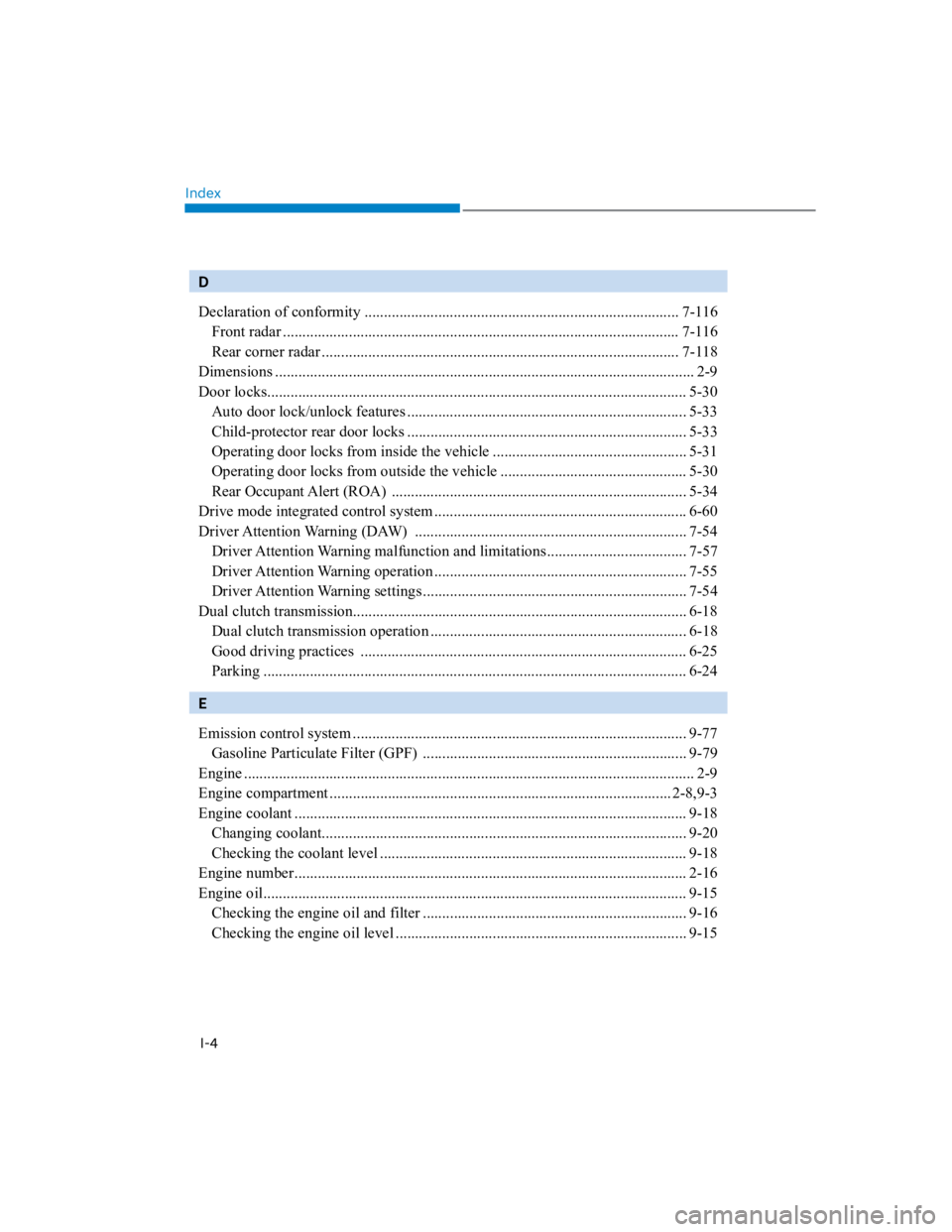Page 531 of 579
![HYUNDAI KONA 2022 Owners Manual 09
9-45
FUSES
OLF074075
A
Blade type
Cartridge type
Multi fuse
A
A
B
B
B
B
A
[A] : Normal, [B] : Blown
A vehicle’s electrical system is protected
from electrical overload damage by
fuses.
This veh HYUNDAI KONA 2022 Owners Manual 09
9-45
FUSES
OLF074075
A
Blade type
Cartridge type
Multi fuse
A
A
B
B
B
B
A
[A] : Normal, [B] : Blown
A vehicle’s electrical system is protected
from electrical overload damage by
fuses.
This veh](/manual-img/35/41169/w960_41169-530.png)
09
9-45
FUSES
OLF074075
A
Blade type
Cartridge type
Multi fuse
A
A
B
B
B
B
A
[A] : Normal, [B] : Blown
A vehicle’s electrical system is protected
from electrical overload damage by
fuses.
This vehicle has 5 fuse panels, one
located in the driver’s side panel bolster,
the other in the engine compartment.
If any of your vehicle’s lights,
accessories, or controls do not work,
check the appropriate circuit fuse. If a
fuse has blown, the element inside the
fuse will be melted or broken.
If the electrical system does not work,
first check the driver’s side fuse panel.
Before replacing a blown fuse, turn the
engine and all switches off, and then
disconnect the negative battery cable.
Always replace a blown fuse with one of
the same rating.
If the replacement fuse blows, this
indicates an electrical problem.
Avoid using the system involved. We
recommend that you immediately
consult an authorized HYUNDAI dealer.
WARNING
NEVER replace a fuse with anything but
another fuse of the same rating.
A higher capacity fuse could cause
damage and possibly cause a fire.
Do not install a wire or aluminum
foil instead of the proper fuse -
even as a temporary repair. It may
cause extensive wiring damage and
possibly a fire.
NOTICE
Do not use a screwdriver or any other
metal object to remove fuses because
it may cause a short circuit and damage
the system.
Page 555 of 579

09
9-69
NOTICE
Do not use strong soap, chemical
detergents or hot water, and do not
wash the vehicle in direct sunlight
or when the body of the vehicle is
warm.
Be careful when washing the side
windows of your vehicle.
Especially, with high-pressure water,
water may leak through the windows
and wet the interior.
To prevent damage to the plastic
parts, do not clean with chemical
solvents or strong detergents.
NOTICE
OOS090046N
Water washing in the engine
compartment including high
pressure water washing may cause
the failure of electrical circuits
located in the engine compartment.
Never allow water or other liquids
to come in contact with electrical/
electronic components inside the
vehicle as this may damage them.
NOTICE
Matte paint finish vehicle (if equipped)
Automatic car wash which uses rotating
brushes should not be used as this can
damage the surface of your vehicle. A
steam cleaner which washes the vehicle
surface at high temperature may result
the oil to adhere and leave stains that is
difficult to remove.
Use a soft cloth (e.g. microfiber towel
or sponge) when washing your vehicle
and dry with a microfiber towel. When
you hand wash your vehicle, you should
not use a cleaner that finishes with wax.
If the vehicle surface is too dirty (sand,
dirt, dust, contaminant, etc.), clean the
surface with water before washing the
car.
A good coat of wax is a barrier between
your paint and contaminate. Keeping
a good coat of wax on your vehicle will
help protect it.
Wax the vehicle when water will no
longer bead on the paint.
Always wash and dry the vehicle before
waxing. Use a good quality liquid or
paste wax, and follow the manufacturer’s
instructions. Wax all metal trim to protect
it and to maintain its luster.
Removing oil, tar, and similar materials
with a spot remover will usually strip the
wax from the finish. Be sure to re-wax
these areas even if the rest of the vehicle
does not yet need waxing.
Page 570 of 579

Index
I-4
D
Declaration of conformity ................................................................................. 7-116
Front radar ...................................................................................................... 7-116
Rear corner radar ............................................................................................ 7-118
Dimensions ............................................................................................................ 2-9
Door locks............................................................................................................ 5-30
Auto door lock/unlock features ........................................................................ 5-33
Child-protector rear door locks ........................................................................ 5-33
Operating door locks from inside the vehicle .................................................. 5-31
Operating door locks from outside the vehicle ................................................ 5-30
Rear Occupant Alert (ROA) ............................................................................ 5-34
Drive mode integrated control system ................................................................. 6-60
Driver Attention Warning (DAW) ...................................................................... 7-54
Driver Attention Warning malfunction and limitations.................................... 7-57
Driver Attention Warning operation ................................................................. 7-55
Driver Attention Warning settings .................................................................... 7-54
Dual clutch transmission...................................................................................... 6-18
Dual clutch transmission operation .................................................................. 6-18
Good driving practices .................................................................................... 6-25
Parking ............................................................................................................. 6-24
E
Emission control system ...................................................................................... 9-77
Gasoline Particulate Filter (GPF) .................................................................... 9-79
Engine .................................................................................................................... 2-9
Engine compartment ........................................................................................ 2-8,9-3
Engine coolant ..................................................................................................... 9-18
Changing coolant.............................................................................................. 9-20
Checking the coolant level ............................................................................... 9-18
Engine number..................................................................................................... 2-16
Engine oil............................................................................................................. 9-15
Checking the engine oil and filter .................................................................... 9-16
Checking the engine oil level ........................................................................... 9-15